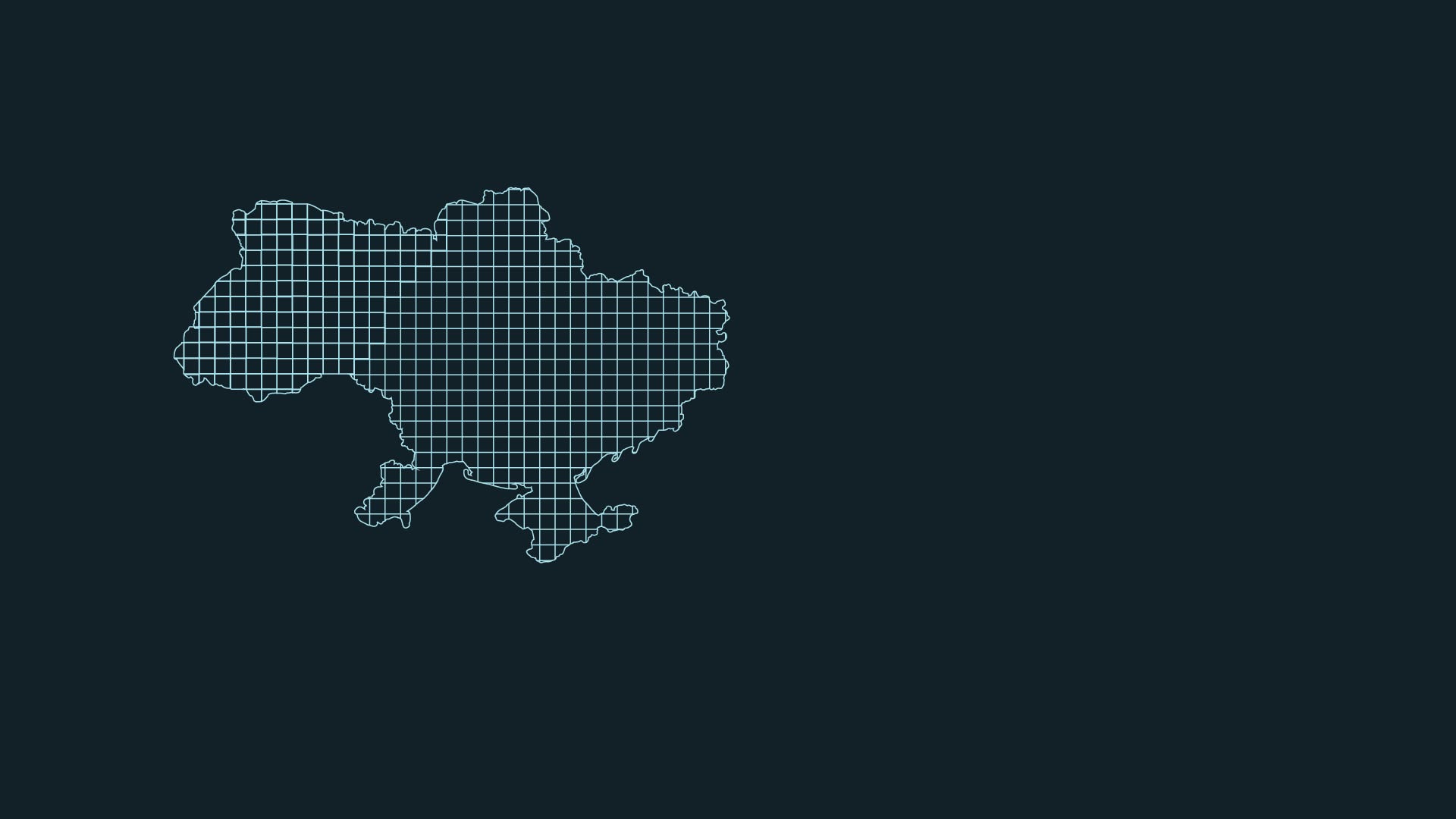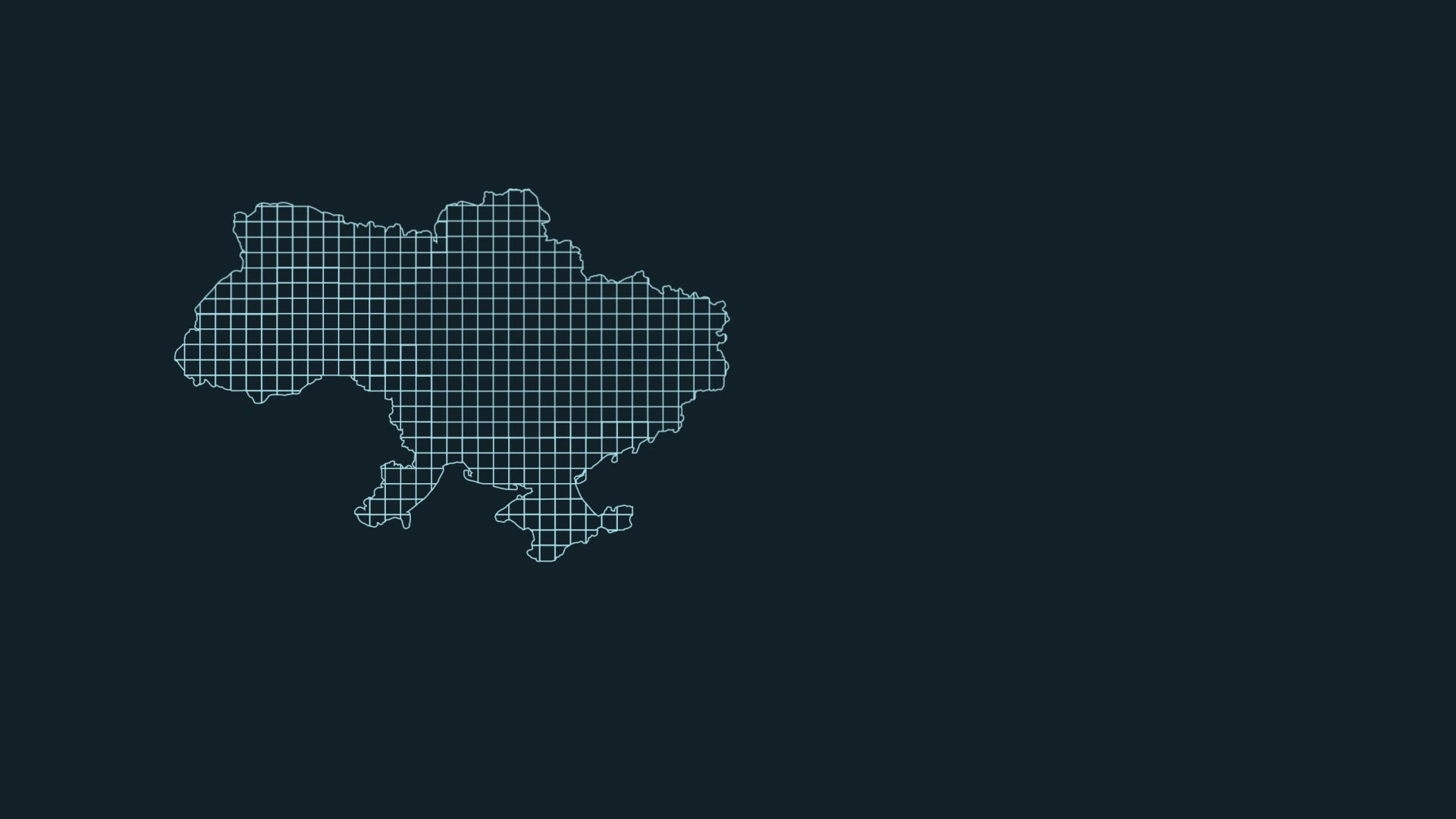Safeguarding the Digital Landscape
Online Opportunities & Threats
for Displaced Ukrainians

When Russia launched its full-scale invasion of Ukraine in February 2022, it sparked the largest and quickest mass displacement of people since the Second World War.
Ukrainians often left their homes with only the clothes on their backs and a small bag—an all-too-common experience in a world experiencing record high levels of forced displacement.
Yet, unlike many other displaced populations, almost all Ukrainians were able to bring their smartphones, a near-unmatched level of tech savviness, and supportive, tightly woven online networks.
This connectivity has presented new opportunities to assist vulnerable people; it has also put those same vulnerable people face-to-face with new online threats that can translate into very real physical danger.
Ukraine's Digital Connectivity

Digitization has always been central to President Zelensky’s vision of Ukraine.
Promises surrounding digitization served a critical role in his almost entirely virtual campaign. At the time, it was seen as a way to both fight corruption and engage the country’s younger generation. However, the long-term impacts of his administration’s efforts in this area can be seen both in the success of the war effort and in the options now open to displaced Ukrainians.
Just months after Zelensky’s election in 2019, the Ukrainian government established the Ministry of Digital Transformation— a trailblazing effort to transform government through the creation of the “state in a smartphone.”
With the goal of making 100 percent of government services available online by 2024, the Ministry of Digital Transformation quickly mobilized to launch Diia—meaning “action”—a mobile app and web platform centralizing citizen access to public services.
In 2021, Ukraine became the first country in the world to issue digital passports through Diia.
After February 2022, the Ukrainian government worked to ensure that Ukraine’s digital connections were both protected and strengthened.
|
Digital Uptake in Ukraine |
||
|
Internet penetration rate |
71.8% |
79.2% |
|
Social media use |
64.6% |
74.0% |
Zelensky’s administration has partnered with Starlink, the European Union, and European telecom companies to ensure that Ukrainians maintain internet connection during the war. This has been essential to countering Russian attempts to control information flows about the war.
Maintaining internet access is also critical to ensure that displaced Ukrainians—both within Ukraine and across international borders—are able to access to public services, personal networks, and aid resources.
Stabilizing Connections

Ukraine’s level of digital connectedness has spurred new opportunities and innovations to aid displaced Ukrainians across several critical areas.
Click the icons to learn more.
Missed Connections

As comprehensive as the digital platforms helping displaced Ukrainians are, certain demographics are at risk of being left behind as they try to access vital resources.
A number of organizations have found that elderly people have struggled to adjust to the mass proliferation of digital tools. A UNDP report found a significant digital divide across different age groups in Ukraine, with over 46 percent of older Ukrainians reporting in early 2022 that they never use the internet. Another study found that 53 percent of Ukrainians have a “below average” level of digital skills—an issue that has become a central focus for the Diia.Education team.
Moreover, people with irregular status are unable to register for Diia, as the user’s information must be registered with the Ukrainian immigration system to gain access to the app. Moreover, users need a Ukrainian bank account and a taxpayer number in order to go through the identification process.
Consequentially, as discussed in a recent CSIS piece, stateless persons in Ukraine are also unable to use the app because they lack any proof of nationality, birth certificates, passports, or residence permits.
Similarly, according to an interview with a civil society organization conducting programming in Ukraine, Ukrainian citizens who reside in Russian-occupied territories such as the Donetsk and Luhansk regions cannot safely use Diia. Using Diia could put them at risk while under Russian occupation, as doing so would mean that they admit to retaining Ukrainian citizenship.
This gap in availability of services and centralized information puts people already vulnerable to exploitation at additional risk of being left out of assistance efforts.
Opportunities for Exploitation

As Ukrainians navigate their journey away from the conflict, the same access to digital information that facilitated their escape can also leave them vulnerable to dangers just as real as those they left back home.
I. TRAFFICKING
Actors with malicious intentions have also capitalized on this proliferation of new digital platforms designed to help Ukrainians.
Even prior to Russia’s invasion, Ukraine faced high levels of human trafficking, as both an origin and destination country for victims.
According to the UN migration agency, over 300,000 Ukrainians have been victims of human trafficking since 1991.
Men, women, and children are all at risk of trafficking, including forced labor, forced sex work, and forced begging.
trafficking
Via kidnapping or coercive recruitment, victims are frequently trafficked to various locations around Europe and Eurasia, such as Russia, Poland, Iraq, Spain, and Turkey.
Just as displaced Ukrainians are using digital tech to help them navigate complex journeys, traffickers are becoming more adept at using these resources to identify, mislead, and capture people.
In September 2022 a Europol-sponsored hackathon identified at least 30 online platforms created to exploit Ukrainian refugees, 10 of which explicitly targeted them for trafficking. In May 2022 an EMPACT action day monitored 125 online platforms, leading to the identification of nine suspected human traffickers.
trafficking
Similarly, a PBS report showed evidence of online listings for rent-free housing in exchange for sex work and housework, as well as scam online advertising for intermediaries who claim to help with immigration paperwork.
In the United Kingdom, the moderators for Facebook groups established to match Ukrainian refugees with resources—including housing arrangements—have witnessed potential traffickers attempting to contact vulnerable people, particularly women traveling alone.
In this way, the proliferation of online aid networks has opened a new portal for traffickers to target, locate, and capture displaced Ukrainians in search of assistance.
trafficking
II. Misuse of information
A generalized lack of trust in available information, combined with complex, confusing, or missing language on official government websites has driven people to overly rely on peer-to-peer information seeking through informal channels. Many of these platforms, such as Facebook, Telegram, and WhatsApp are particularly susceptible to mis- and disinformation.
Malign actors—including the Russian state—use these networks to spread false information. During the March 2022 invasion, a variety of popular Telegram channels spread false information claiming that Russia had taken critical Ukrainian cities. Soon after the March 2022 invasion, Russian actors used social media platforms to attempt to discredit reports about their attack on a Mariupol hospital.
misuse of information
Additionally, many small organizations and startups created their own online platforms in the wake of the invasion but failed to keep them updated. While likely unintentional, the proliferation of online information sources resulted in “digital litter”—an abundance of broken links and websites with outdated or false information.
People trying to plan how to flee Ukraine, find resources, or locate employment opportunities must sort through outdated, unclear, or even false information.
misuse of information
III. cybercrime
Bad actors see opportunity in vulnerability.
Cyberspace is filled with scammers, hackers, and websites that seek to take advantage of people in search of jobs, legal assistance, or humanitarian aid.
In 2022, nine people were arrested for operating over 400 phishing sites claiming to offer financial benefits to Ukrainians. They are estimated to have stolen over $3,360,000 from approximately 5,000 victims.
cybercrime
People receiving displaced people in their homes have also become targets online. Fraud schemes, including fake financial assistance for hosts, fake donation websites, and illegitimate fundraising campaigns have led people in host countries to send money directly to scammers.
Similarly, some host countries are worried that malign actors are using unknowing hosts to gather sensitive data about refugees from Ukraine. For example, government officials in Poland, Lithuania, and the United Kingdom have warned of fake letters circulating on social media asking hosts of Ukrainian refugees to share personal information about their guests.
cybercrime
IV. toxic online narratives and hate speech
Since the beginning of the invasion, there has been an uptick in hate speech acts propagated via social media.
In early 2023 there were reports of anti-Ukrainian narratives circulating through Polish Twitter, with some tweets using xenophobic hashtags. A study by the Centre for Information Resilience concluded that compared to previous years, 2022 saw an increase in the use of nationalistic slurs against Ukrainians on Twitter and Telegram, including from verified blue-check accounts.
toxic online narratives and hate speech
Telegram channels dehumanizing the plight of Ukrainians and distributing hateful and disturbing media—sometimes depicting corpses or attacks alongside hateful narrations and captions—were identified as well.
These practices can be both a root cause of forced displacement and a protection threat to the displaced.
In some cases, these narratives can cause potential host communities to reject migrants; in others, they might lead refugees to be more reticent to accept aid from legitimate sources.
toxic online narratives and hate speech
Rogue actors have successfully exploited online platforms to promote trafficking and cybercrimes.
However, the use of mis- and disinformation and the proliferation of toxic online narratives and hate speech can be prevented.
Digital Protection

Even as the war wages on, actors making use of digital tools can work to support the safety and integrity of information and services provided to displaced Ukrainians.
I. Fight Cybercrime
Aid actors implementing digital programming should work to train refugees and volunteers on how to spot and combat suspicious activity online.
For example, UNHCR, according to interviews, is conducting training on digital issues with its staff in Ukraine. IOM Ukraine has similarly taken an innovative approach to training displaced Ukrainians on how to spot online threats. IOM developed two online games (one targeted at children and one at adults) where users engage in a “quest,” making a series of difficult decisions mirroring the experiences and threats faced by displaced Ukrainians during the war. At the end of the game, the pros and cons of each decision are explained.
fight cybercrime
In addition to helping users learn to make smarter decisions about whom to trust when on the move, IOM’s platform has also been used to offer current information—including a road map—on best practices for displaced persons. However, while the game itself is digital, it does not address the threats that Ukrainian refugees are likely to encounter in the digital landscape. This gap has at least partially been filled by the Diia.Education team, which developed online guides and simulators walking Ukrainians through combating human trafficking, promoting online safety for children and elderly populations, and implementing best practices for cybersecurity.
fight cybercrime
II. Improve Vetting for Digital Programming
Organizations must implement stringent vetting procedures for aid and programming that is organized or advertised online.
UNHCR has already started upping vetting procedures for volunteers and discouraging beneficiaries from accepting help from unregistered volunteers. Similarly, Airbnb.org—the company’s nonprofit arm—implemented a vetting procedure to review hosts before they were matched with displaced Ukrainians. Still, the vetting procedures of various organizations, including Airbnb, have been criticized as falling short of what is necessary to truly protect the displaced, in part because they did not include substantive background checks.
Improve Vetting for Digital Programming
Implementing a comprehensive vetting process is often laborious for an aid organization and can slow down aid dispersal. However, it is critical to ensure that aid programs do not place the displaced directly in harm’s way. Similarly, although efforts to individually vet volunteers and share locations are smart practice, the onus should not be on vulnerable displaced persons themselves.
Improve Vetting for Digital Programming
III. Reduce Digital Litter
Digital litter leads displaced persons to rely on misleading or unavailable information.
Both governments and other actors should work to clear the web of outdated portals and simplify language online.
Several organizations and researchers are now aware that the abundance of unusable links and outdated information online represents an important downside to using the digital space to distribute information. There are many in the tech space who are willing to volunteer to clear digital litter if the right campaigns are run.
Reduce Digital Litter
Similarly, social media influencers and actors should be urged to carefully date and archive any information they publish and, should efforts cease, be responsible for clearing their digital footprint.
Since many of these independent platforms are born out of a need for clearer information and conciseness, governments should work toward simplifying their website language, date and update content, display information in different languages and dialects, establish Q&A sections in their portals, and enable chatbots or a channel for feedback and questions.
Reduce Digital Litter
IV. Work with Ukrainian Civil Society to Create Trust
If digital programming is going to be effective, displaced Ukrainians must be able to trust the information they find online. Actors should look to campaigns created in other contexts to create a campaign promoting trust in credible online information. Notably, lessons could be taken from the “Confía en el Jaguar” campaign—launched by UNHCR and Facebook in Mexico in 2016—which used the symbol of the jaguar to mark trustworthy migration information available through social media.
Along similar lines, IOM created a Telegram hotline for Ukrainians looking to quickly verify online information. By scanning a QR code, users are taken to a Telegram chat room, linked with a hotline where users can engage with a real person in real time.
Work with Ukrainian Civil Society to Create Trust
UNHCR has similarly launched a pilot of its messaging service (first piloted in Ecuador in 2020), offering frequently updated automated responses to aid queries. The platform also functions to connect refugees with specialized staff to help them answer questions that cannot be answered by the messaging service.
By working proactively to fight cybercrime, improve vetting procedures, reduce digital litter, and create trust in online information, state and non-state actors alike have the opportunity to develop a virtual world where displaced Ukrainians can thrive, despite the realities of the war.
Work with Ukrainian Civil Society to Create Trust
Ukraine's
Digital Future

Much of the world has rallied to support Ukraine.
Digital innovations like Diia have rightly been celebrated as a means to keep Ukrainian refugees connected, despite the devastation caused by the ongoing Russian war of aggression.
Yet, a proliferation of digital resources and aid has translated to a growth of new, unmoderated platforms. While many of these initiatives were created with good intentions, many also lack the controls to prevent exploitation. Global actors should take care to avoid creating opportunities for malicious actors to exploit digitally connected—yet still vulnerable—displaced Ukrainians.
Many Ukrainian refugees are getting smart about their interactions online and implementing their own vetting procedures. But they shouldn’t have to do this work alone.
Individuals and aid organizations seeking to use digital tools to help Ukrainians have a responsibility to engage in digital protection and to consider all of the uses—and misuses—of the platforms and resources they create.
As Ukraine pushes forward toward the end of the war, the decisions made today about the country’s digital space have the opportunity to shape its reconstruction process. Building a safer digital space now means that Ukraine will be all the more ready to embrace a truly digital future.
Made possible by the generous support of the Open Society Foundations.
Authors
Abigail Edwards, Research Assistant, CSIS Project on Fragility and Mobility
Ángeles Zúñiga, Former Research Intern, CSIS Project on Fragility and Mobility
Erol Yayboke, Former Director, CSIS Project on Fragility and Mobility
Special Thanks
- Marti Flacks, CSIS Human Rights Initiative
- Lauren Burke, CSIS Human Rights Initiative team
- Iryna Tiasko, CSIS Human Rights Initiative team
- David Lotfi, iDeas Lab
- Claire Smrt, iDeas Lab
iDeas Lab Story Production
Design concepts, cover, and production by: Sarah B. Grace
Scrollmation design by: Vardan Sargasyan
Animated maps by: Michael Kohler
Data visualizations by: Lindsay Urchyk, Shawn Fok, and Fabio Murgia
Edited by: Sarah B. Grace
Copyediting support by: Katherine Stark
Photo Credits
Cover: Refugees fleeing Ukraine use their smartphones to send messages at the Velke Slemence border crossing on March 13, 2022, in Velke Slemence, Slovakia. | Christopher Furlong/Getty Images
Digital Connectivity in Ukraine: A Ukrainian Telegram group message is seen on a phone at the Polish border | ITN via Getty Images
Opportunities for Exploitation: Assets via AdobeStock by Vectorfusionart, SergeyBitos, Валерия Соловьева, Vitalii, Ihor, Valerybrozhinsky, German Ovchinnikov, Sdecoret, Newb1
Digital Protection: Assets via AdobeStock by Pickup, SergeyBitos, Ihor, Katya. Assets via Wikimedia Commons by William John Gauthier, Tohaomg.